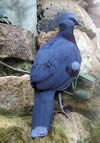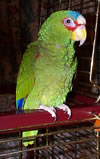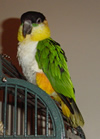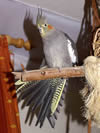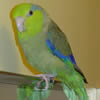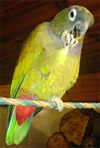Pet Birds
Since there are so many types of pet birds it is usually possible to find one that suits you and your life style – if you are willing to do some research. Simply walking into a pet shop and getting any bird that looks nice is not a clever way to go about. Some types of pet birds will for instance live for 50 years or more – are you ready for that type of commitment? Other types of pet birds are incredibly noisy (or adorably chatty, if you are the right person for such a bird) and can disturb their keeper as well as any neighbours. Some birds grow really big and require expensive cages or even aviaries, while others are so clever that they succumb to depression and lethargy in a boring household where they aren’t given any intricate puzzles to solve. There are also birds that must be kept in pairs or groups, especially if you plan on ever leaving them home alone. These are just a few things that you have to take into account when choosing a pet bird.
Types of Pet Birds
|
FinchesAll true finches belong to the family Fringillidae, but many types of pet birds from other families have the word finch in their common name since they look similar to the true finches. Two of the most commonly kept pet true finches are Zebra finch (Poephila guttata) and Society finch (Lonchura domestica). The House finch (Carpodacus mexicanus) also has a history of being kept as a pet and the populations found in Eastern and Midwestern United States hail from released and escaped pet finches. Finches are known to having strong and stubby beaks; an adaptation to a diet consisting chiefly of hard seeds. Pigeons and dovesPigeons are one of the oldest types of pet bird and have been kept for thousands of years – as pets, for food, and to deliver messages. The ever present pigeon colloquially referred to simply as Pigeon is a domesticated version of Rock Pigeon, Columba livia. Today, you can find feral populations of this bird around the globe. There are no steadfast rules regarding the use of the two terms pigeon and dove, but ornithologists tend to reserve the word pigeon for larger species and use dove for smaller ones. Regardless of what you call them, pigeons and doves all belong to the family Columbidae. ParrotsThere are roughly 370 known species of parrot and many different types of pet birds belong to this group. African greys, budgerigars (“budgies”), parakeets, rosellas, lovebirds, parrotlets, caiques, cockatoos, cockatiels, conures, pionus birds, macaws, and amazons – they are all parrots. Most parrots live in tropical and subtropical climates but there are actually a few temperate species as well. The greatest diversity of parrots is found in South America and Australasia. African Grey ParrotThe African Grey Parrot, Psittacus erithacus, is considered one of the most intelligent birds in the world. It can mimic not only human speech but a long row of other sounds as well, including the calls of other birds. Some individuals even have a documented ability to understand the meaning of words, e.g. associate the word for red with the colour red, and can use this capacity to construct sentences. The African Grey Parrot inhabits primary and secondary rainforests in West and Central Africa and needs old trees with cavities for nesting. Just like other clever types of pet bird, the African Grey Parrot must be given plenty of mental stimulation in captivity; things to investigate and puzzles to solve; otherwise it will become bored and depressed. Amazon ParrotAmazon parrots comprise the genus Amazona in the parrot family Psittacidae. There are 25-30 described species of Amazon parrot; all hailing from South or Central America (including Mexico and the Caribbean). This type of pet bird is similar to African Grey Parrots in their ability to mimic sounds, including human speech, and their constant need for mental and social stimulation. They can for instance learn the name of objects in their environment. Amazon parrots are predominantly green but many species sports striking accenting colours. Amazon parrots are usually very noisy at sunrise and sunset, in the wild as well as in captivity. CaiquesThe Caiques are two colourful and comparatively small parrots in the genus Pionites: Pionites leucogaster and Pionites melanocephalus. The first one is commonly known as White-bellied Caique while the later is referred to as Black-headed Caique. Both are endemic to the Amazon Basin. Compared to many other types of pet bird, Caiques are not very good at imitating human speech. Those individuals that do will speak in a soft, gravelly voice. Caiques are on the other hand really good at imitating machine sounds, so prepare to hear a lot of microwave beeps, door bells and alarm clocks. They are also fond of whistling tunes and composing their own ones. CanaryThe domestic canary (Serinus canaria domestica) hails from the wild canary (Serinus canaria), a bird native to a few islands off Western Europe and Africa: Madeira, the Azores and, of course, the Canary Islands. Domestic canaries have been bred for centuries and were brought to Europe by Spanish sailors. Today, there are tree main types of domestic canary: song canaries, colorbred canaries, and type canaries (type canaries are bred for their shape). Among the first ones to breed canaries in Europe were Christian monks who gained a monopoly on this type of pet bird by only selling male canaries to the public and keeping the hens for themselves. CockatielsThe Cockatiel, Nymphicus hollandicus, is a small Australian cockatoo. The name is derived from kakatielje, which means “small cockatoo” in Dutch. This bird is also known as Quarrion bird and Weiro bird. Cockatiels inhabit the Australian outback, including scrublands, bushlands and wetlands. They are nomadic and will move from place to place to find new food and water. In the wild, cockatiels live in pairs or small flocks, but desirable spots such as water holes can attract hundreds of cockatiels at a time. Since this is such a social bird it will appreciate the company of fellow cockatiels in captivity. Like many other types of pet bird it can bond strongly to its human keeper even when kept with other birds. CockatooCockatoos belong to the family Cacatuidae and are only found in Australia, Indonesia, and New Guinea plus a few smaller islands in south-eastern Asia. The name Cockatoo comes from the bird’s Malay name: kaka(k)tua. The parrot order Psittaciformes contains tree families and Cacatuidae is one of them, the other ones being Psittacidae (true parrots) and Nestoridae. Cockatoos are curious birds that need a lot of things to explore to prevent boredom. They are high-maintenance types of pet birds and are often kept in pairs since they need a lot of social interaction to stay happy and healthy. In the wild, cockatoos form flocks comprised of anything from eight individuals to several thousands of birds. ConuresThe term conure is used for a diverse, loosely-defined group of small to medium-sized parrots. The group is not a taxonomic group consisting of related species and is therefore used by pet keepers rather than avian researchers. You can find many different types of pet birds within this haphazard group. Generally speaking, conures are slender birds with short, broad beaks and they vary in size from 23 cm (9 in) to 48 cm (19 in). Some have elongated tail feathers while others have short, narrow-tipped ones. Some conures are becoming increasingly rare in the wild, including the Blue-chested Conure (Pyrrhura cruentata) and the Queen of Bavaria (Aratinga guarouba). MacawsMacaws are famous for the flamboyant appearance, with large species normally being showier than smaller ones. All macaws are native to South- or Central America (including Mexico) where they inhabit rainforests, woodlands or steppes depending on species. The largest macaw is the Hyacinth Macaw (Anodorhynchus hyacinthinus) which can reach a length of 100 cm (39 in) and have a wingspan of up to 140 cm (56 in). All macaws have long wings, a long tapered tail and a really big head. The larger species can crack even the most difficult nuts using their powerful beaks, such as big palm nuts. Macaws are very lively and must be provided with suitable outlets for all their energy in captivity, otherwise these types of pet birds can develop undesirable and destructive habits. They are used to living in chatty flocks and will spend a lot of time chitchatting with their human keeper or with other birds in the home.ParrotletAs the name suggests, parrotlets are smaller than most other true parrots and an appreciated type of pet bird among keepers who want a bird that does not require a huge cage. Parrotlets have stocky bodies and broad tails and will rarely exceed 13 cm (5 in) in length. The family Psittacidae (true parrots) contains three genera of parrotlets: Forpus, Nannopsittaca and Touit. All species are native to South or Central America where they have adapted to a wide range of environments, including deciduous forests and scrubland. Parrotlets live and travel in flocks and later in the year you can encounter flocks consisting of over hundred parrotlets. Two examples of commonly kept parrotlets are the Pacific Parrotlet (Forpus coelestis) and the Mexican Parrotlet (Forpus cyanopygius). ParakeetThe term parakeet is not a taxonomic term and means different things to different people. In American English, the name parakeet is chiefly used for the budgerigar (Melopsittacus undulates) only; a popular pet known simply as budgie in British English. Outside the U.S. the term parakeet is commonly used for a large number of unrelated small to medium sized parrot species, most of them sporting long tail feathers. Many different types of pet bird can be found in this group as well as a lot of wild species that have never been kept as pets. Generally speaking, smaller parrots with long tail feathers are more often referred to as parakeets only, while larger parrots with long tail feather are called parrots and parakeets interchangeably. PionusPionus is a genus of medum-sized parrots native to Central and South America. These types of pet birds are sometimes confused with Amazon parrots, but Pionus parrots are significantly smaller. The body is stocky with a short tail and the undertail coverts are always brightly red. Because of these red feathers found underneath the tail, Pionus birds were earlier known as Red-vented parrots. There are six recognized species of Pinonus and two subspecies. If your Pionus bird becomes startled or exited it can start wheezing and sound like it is having an asthma attack. This is not a respiratory problem; it is a just the way agitated Pionus birds sounds. RosellaRosellas are colourful parrots found native to mainland Australia and a few nearby islands, including Tasmania. Rosellas have adapted fairly well to European settling and are today found not only in forests but in farmlands, parks and gardens as well. They have also become established in New Zealand after being brought there by man. All Rosellas belong to the genus Platycercus. They thrive only in coastal regions and you cannot find them in the Australian outback. These types of pet birds are especially common in Australia due to the country’s strict import and export restrictions. One example of a commonly kept Rosella is the Eastern Rosella, Platycercus eximius. |


